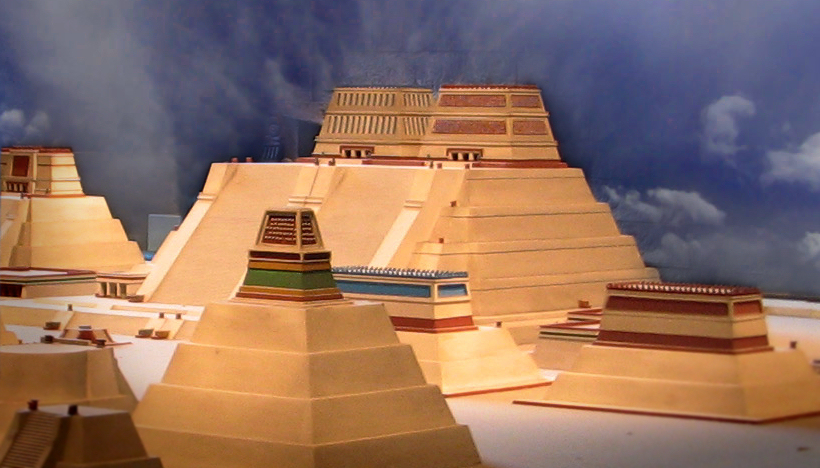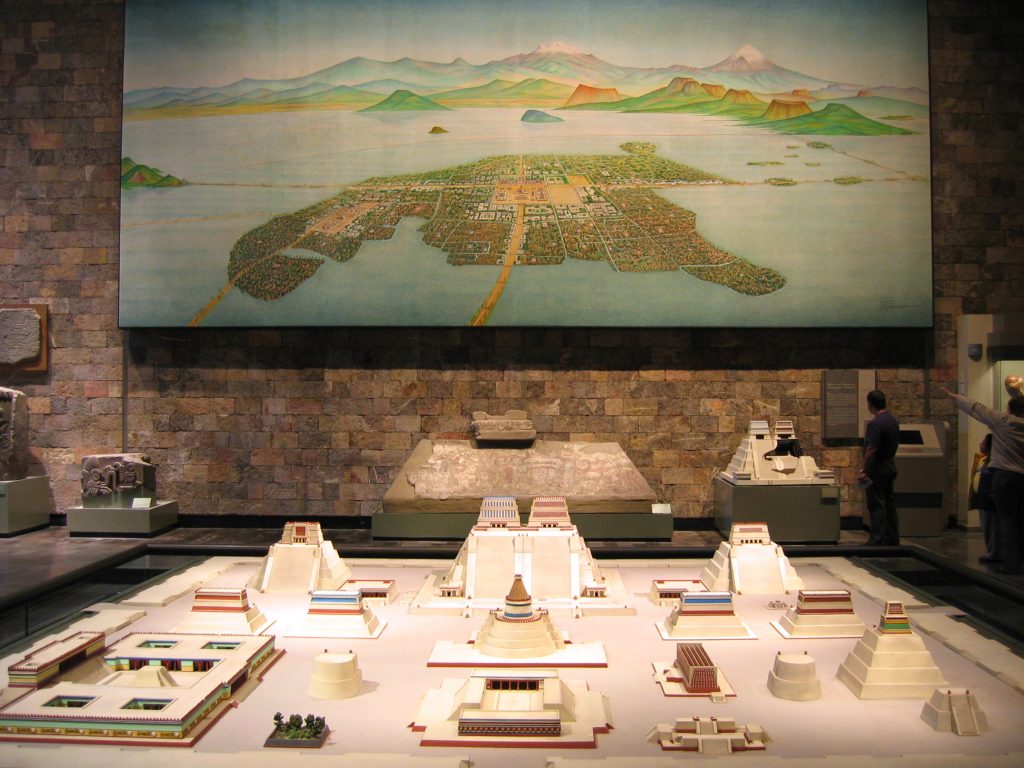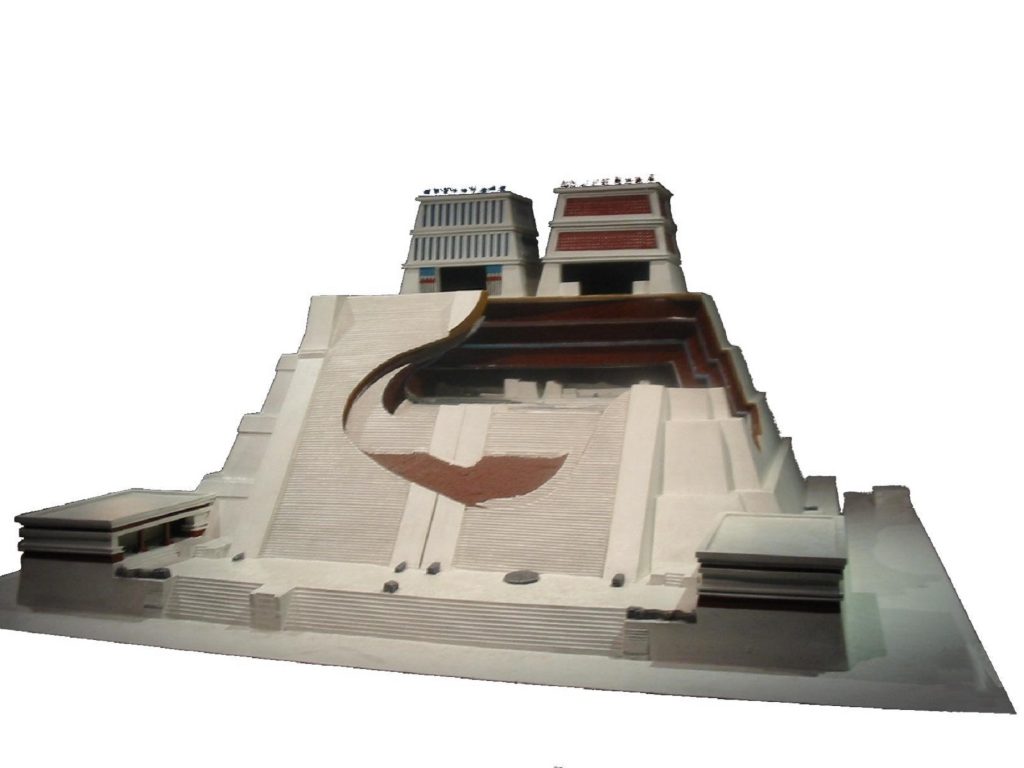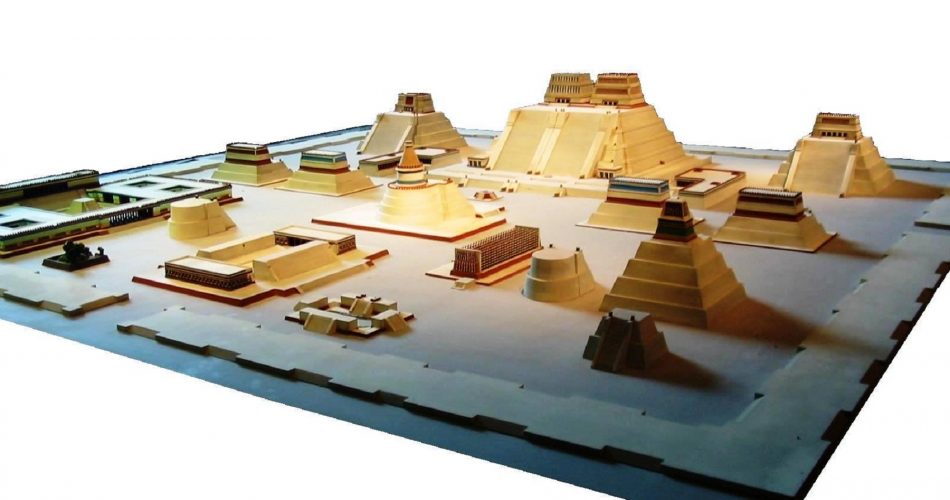One of the perhaps lesser-known, yet extremely important ancient cities of Mexico is located in the heart of present-day Mexico City.
Its name; Tenochtitlan, and it served as the capital of the Aztec Empire until it was eventually captured by the Spanish Conquistadores in 1521.
Like many other cities across Mesoamerica, the exact foundation of the city of Tenochtitlan remains shrouded in mystery.
At its peak, the capital of the Aztec empire was the largest city in pre-Columbian America.
According to archaeologists, the city covered around 13.5 square kilometers.
Among all cities in Mexico, Tenochtitlan was unique. It was America’s Atlantis. The entire city was built on an island in what was then Lake Texcoco in the Valley of Mexico.
Today, the city lies in ruins after destruction by the Spanish Conquistadors. Only its ancient ruins remain in the historic center of Mexico’s Capital. Its etymology is uncertain, but experts believe its name translates into “Among the prickly pears [growing among] rocks.”
However, that may be no more than guesswork, and its original name my remain untranslated.
According to a 16th-century manuscript, the Bancroft Dialogues,” the etymology of Tenochtitlan remains uncertain.

The Mesoamerican Atlantis
“When we saw so many cities and villages built in the water and other great towns on dry land we were amazed and said that it was like the enchantments (…) on account of the great towers and cues and buildings rising from the water, and all built of masonry. And some of our soldiers even asked whether the things that we saw were not a dream? (…) I do not know how to describe it, seeing things as we did that had never been heard of or seen before, not even dreamed about.”
Bernal Díaz del Castillo, The Conquest of New Spain. (source)
The foundation of the city is a mixture between history and legends, a distinctive trait of the indigenous American regions.
Sixteenth-century sources that correlated ancient calendars with Westerners placed the foundation of the city in 1325.
However, there are no accounts that date back to the original foundation of the city.
The legend of the foundation of the ancient city narrates that México-Tenochtitlan was populated by a group of Nahua tribes migrating from Aztlán, a place whose precise location remains another historical enigma.
Although we don’t know the location of Azlatn, historical sources place it somewhere to the north of Tenochtitlan.
Some have even proposed that Azlatn was located somewhere in the present-day USA.
To date, no evidence has been found to support the city was real.
The legend tells us that there were seven ancient tribes that lived in the “place of the seven caves,” known as Chicomoztoc.
Each of the groups represented a different Nahua group.
Th Aztecs were told by their god Huitzilopochtli to venture out and seek a place where they would build their new capital city. Huitzilopochtli said to the Aztecs they would known where to build their city because the precise spot would be marked by an eagle sitting on a prickly-pear cactus (nopal) and devouring a snake.
After a long journey, the people who fled from Chicomoztoc saw what Huitzilopotchli had foretold at Lake Texcoco, which is where the Aztecs built the capital of their empire.
By the time the Spanish Conquistadors came to Tenochtitlan, the city was massive; it comprised both Tenochtitlan and Tlatelolco. The city was built on an island on a lake, and the city was connected to the mainland by artificial bridges and causeways leading to the north, south, and west.
“The city is as big as Seville or Cordoba. The main streets are very wide and very straight; some of these are on the land, but the rest and all the smaller ones are half on land, half canals where they paddle their canoes.”
An Age of Voyages: 1350-1600, by Mary Wiesner-Hanks, Oxford University Press, 2005.
The causeways built by the Aztecs were interrupted by various bridges that allowed marine traffic to pass around the city. These bridges also served as important defensive structures as they could be pulled away if necessary to defend the capital from attacks.
Similar to how Plato described Atlantis, Tenochtitlan was interlaced by a series of canals that connected all of the sections of the city.
This meant that the city could be visited by foot as well as via boat (canoe).
The size of Tenochtitlan was such that, when the Spanish conquistadors came to the city, they were left awestruck not only by the immense size of the city but by its development both sociologically and economically.
A reference to a vast marketplace at Tenochtitlan can be found in the book “An Age of Voyages.”
Tenochtitlan ha a great marketplace where “sixty thousand people come each day to buy and sell… Its merchandise included ornaments of gold and silver, lead, brass, copper, tin, stones, shells, bones, and feathers …”
The city was symmetrically beautiful.

According to reports, the center of the city featured various public buildings, including beautifully decorated temples, and palaces.
Inside a walled square, 500 meters on each side, was the ceremonial center used for social gatherings and ritual practices.
It is estimated that the core of Tenochtitlan was home to around 45 public buildings, including the Templo Mayor, one of the most important ancient structures dedicated to the Aztec patron deity Huitzilopochtli and the Rain God Tlaloc.
The heart of Tenochtitlan was comprised of the temple of Quetzalcoatl; ball courts and the terrifying tzompantli or rack of skulls. Tenochtitlan’s Sun Temple was dedicated to Tonatiuh and was also located at the center of the city.
The center of the city was also home to “The Eagle’s house” which was associated with the Aztec Warriors.
Tenochtitlan was also home to massive platforms where the gladiatorial sacrifice was held.
Just outside of ti, the Aztecs built a massive palace for Moctezuma with 100 rooms. Each room reportedly had its own bath. The Emperor’s palace was used by the lords and ambassadors of allies conquered by the Aztecs.
But more importantly, the first descriptions of the ancient city reveal ti was built with great care and symmetry.
Tenochtitlan was one of the earliest cities that had a person (or group of people) in charge of city planning.
This meant that all be buildings were needed to be approved by the supervisor referred to as calmimilocatl, who was essentially a functionary in charge of city planning.
Templo Mayor; Tenochtitlan’s Great Pyramid

The “Templo Mayor” at Tenochtitlan—now in ruins—was the city’s great Pyramid.
It was essentially a Step Pyramid with two temples placed on its summit.
Since the exact age of the founding of Tenochtitlan remains a mystery, so does the construction of the temple. Nonetheless, it is believed that the Aztecs began constructing the first version of the pyramid after 1325.
The first stage of the pyramid was probably built using soil and perishable wood, which means the temple did not survive long.
The second stage, or second temple, is thought to have been built between 1375 and 1427, with more durable materials.
But like other pyramids across Mesoamerica, this pyramid too was developed into a bigger monument.
It is believed that the third level of the pyramid was built sometime between 1427 and 1440 when the Aztecs created a staircase.
The Fourth Temple was built during the reign of Moctezuma I. Scholars believe that it was during this stage when the richest decorations were carved onto the great platform.
The fifth temple was built during the reign of Tizoc. During this construction process, the pyramid’s ceremonial plaza was paved, and the platform was covered in stucco.
The sixth temple of Tenochtitlan was built during the reign of Ahuizotl, who finished some of the improvements that were ordered by Tizoc. Ahuizotl is also thought to have walled off the sacred precinct of the city and decorated the wall with beautifully carved serpent heads.
The final version of Tenochtitlan’s Great Pyramid was the seventh temple and the monument across which Hernan Cortes stumbled upon when he came to Tenochtitlan.
When Cortes entered the city, he was left awestruck by its size. At this time (1519) it was believed that Tenochtitlan was amongst the largest cities on Earth, alongside Paris and Constantinople. Experts estimate that around 300,00 people lived at Tenochtitlan and its surrounding area. To put Tenochtitlan’s size in perspective, historians estimate it was five times the size of the London of Henry VIII.
“The city is spread out in circles of jade, radiating flashes of light like quetzal plumes, Besides it the lords are borne in boats: over them extends flowery mist. “
(Coe, 192)
Most of what we know about the pyramid comes from the historical record. This isn’t much, but we know that the Templo Mayor was the largest and most important structure in the city.
The Pyramid was a towering structure, the tallest in the city. Although most of what we know is historical and archaeological guesswork, we can conclude that the pyramid itself was made out of four sloped terraces. Each terrace had a passage leading between them. It was topped by the great platform, a massive structure measuring 80 by 100 meters (262 by 328 feet).
The pyramid was built with two stairways which gave access to the shrines located atop the pyramid. Each shrine was dedicated to a different deity. One was built honoring Tlaloc, the Aztec deity of water, and the other one was built in honor of Huitzilopochtli, the Aztec deity of the Sun and War.
The Pyramid rose to a height of 60 meters. The entire pyramid is thought to have been covered by stucco and poly-chrome pain, making the pyramid stand out from surrounding structures.
It is believed that Templo Mayor stands at the exact location where the god Huitzilopochtli gave the Mexica people his sign that they had reached the promised land: an eagle on a nopal cactus with a snake in its mouth.
The significance of the pyramid resides in the fact that the structure is thought to represent the “Hill of Coatepec”, where Mxica myth tells that the god Huitzilopochtli was born.
But perhaps even more interesting is the fact that, like many other pyramids across the world, the Great Pyramid at Tenochtitlan was aligned.
Its levels are believed to represent the cosmology of the ancient Aztecs. The temple is aligned with the cardinal directions, with gates connecting roads leading on these directions.

